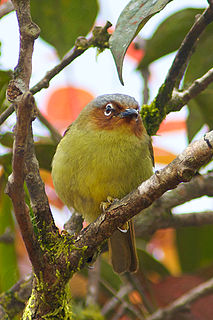TIT, Tit, Tits, or tit may refer to:

The pin-striped tit-babbler, also known as the yellow-breasted babbler, is a species of Old World babbler found in South and Southeast Asia.

Gleaning is a feeding strategy by birds in which they catch invertebrate prey, mainly arthropods, by plucking them from foliage or the ground, from crevices such as rock faces and under the eaves of houses, or even, as in the case of ticks and lice, from living animals. This behavior is contrasted with hawking insects from the air or chasing after moving insects such as ants. Gleaning, in birds, does not refer to foraging for seeds or fruit.

The striped wren-babbler is a species of bird in the family Pellorneidae. It is monotypic within the genus Kenopia. It is found in Brunei, Indonesia, Malaysia, and Thailand. Its natural habitats are subtropical or tropical moist lowland forest and subtropical or tropical swampland. It is threatened by habitat loss.

Macronus, the tit-babblers, are a genus of passerine birds in the family Timaliidae. This genus's name is frequently misspelled as Macronous.
The grey-faced tit-babbler is a species of bird in the family Timaliidae. It is found in Cambodia, Laos, and Vietnam, where its natural habitat is subtropical or tropical moist lowland forest.
Micromacronus is a bird genus in the family Cisticolidae endemic to the Philippines. Long considered to be monotypic, its members are known as miniature babblers or miniature tit-babblers. As the scientific as well as the common names indicate, their habitus resembles a diminutive version of the tit-babblers (Macronus). The genus was only described in 1962, upon the description of the first species, which had been collected by collector Manuel Celestino and Godofredo Alcasid, a zoologist at the Philippine National Museum. The genus was formerly placed in the family Timaliidae but a molecular phylogenetic study published in 2012 found that the genus was more closely related to species in the family Cisticolidae.
The Palawan striped babbler is a species of bird in the family Zosteropidae. It is endemic to the Philippines.
The Panay striped babbler is a species of bird in the family Zosteropidae. It is endemic to Panay (Philippines).
The Negros striped babbler is a species of bird in the family Zosteropidae. It is endemic to Negros Island (Philippines).

The Luzon striped babbler is a species of bird in the family Zosteropidae. It is endemic to the Philippines.

Zosterornis is a genus of passerine bird in the Old World babbler family Zosteropidae, although some taxonomists continue to place the genus in the Old World babbler family Timaliidae. The genus is endemic to the Philippines.

The bold-striped tit-babbler is a species of Old World babbler found in Southeast Asia.

The jungle babblers, Pellorneidae, are mostly Old World passerine birds belonging to the superfamily Sylvioidea. They are quite diverse in size and coloration, and usually characterised by soft, fluffy plumage and a tail on average the length of their body, or longer. These birds are found in tropical zones, with the greatest biodiversity in Southeast Asia and the Indian subcontinent.

Fambong Lho Wildlife Sanctuary is a 51 km2 (20 sq mi) large wildlife sanctuary in East Sikkim district of the state of Sikkim in India. It is contiguous with Khangchendzonga National Park and located around 30 km (19 mi) west of Gangtok. It hosts a few small hamlets inside, namely Dikchu, Pangthang, and Mangan and is managed by State Forest Department.
This page is based on this
Wikipedia article Text is available under the
CC BY-SA 4.0 license; additional terms may apply.
Images, videos and audio are available under their respective licenses.







